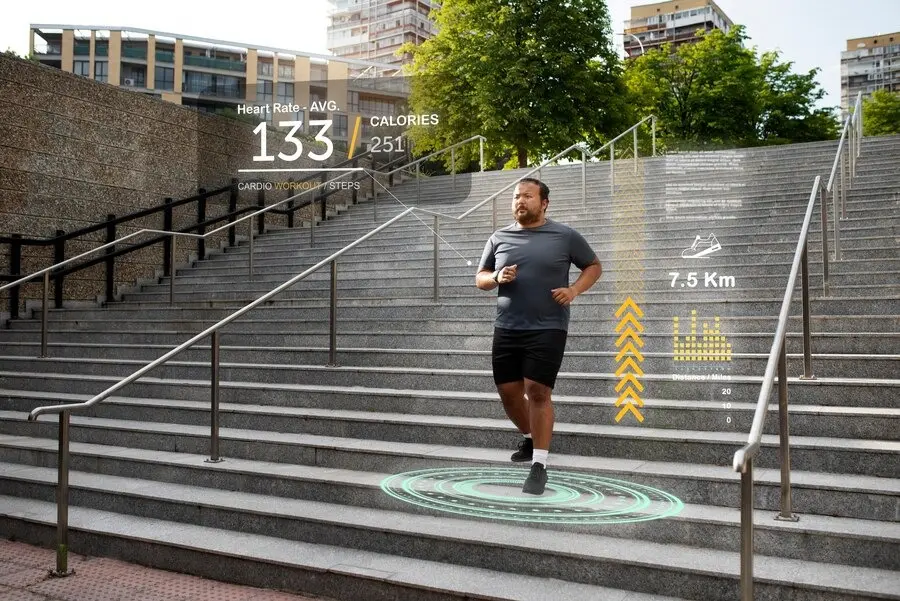Step Up Your Health: The Easy Guide to Reaching Your Daily Step Goal

Are you perplexed about the ideal number of steps needed each day to boost your well-being? In the realm of fitness goals, the much-touted benchmark of 10,000 steps has gained widespread recognition. However, let’s delve deeper into this realm of step counts and unveil the reality behind this oft-repeated “magic number.”
This article aims to demystify the age-old adage of achieving 10,000 steps a day for optimal health. Walking enthusiasts, fitness novices, and those striving for a healthier lifestyle may have encountered this widely circulated notion. But is this number truly the holy grail of fitness? Are there nuanced insights beyond this numerical target that can revolutionize our approach to daily physical activity?
Join us on this exploration as we uncover the truth behind the 10,000-step guideline. By dissecting the concept, we’ll unearth personalized strategies and unveil a more nuanced perspective on step counts, busting myths while shedding light on the real essence of achieving a healthier, more active lifestyle. Let’s embark on a journey beyond the numbers and discover the practicality and authenticity behind achieving a truly beneficial daily step count.
Benefits of Walking and Physical Activity
Physical activity, especially walking, is a powerful contributor to overall health and well-being, offering a wide array of benefits across various aspects:
- Cardiovascular Health: Regular walking and physical activity play a significant role in cardiovascular health. They strengthen the heart by enhancing its efficiency in pumping blood, thereby lowering blood pressure and improving overall circulation. This reduces the risk of heart-related issues like heart attacks, strokes, and coronary artery disease.
- Mental Well-being: Walking and physical activity have profound mental health benefits. They reduce stress by releasing endorphins, fostering a positive mood. Additionally, regular walking sessions improve cognitive function, enhancing focus, memory, and mental acuity. Physical activity is also linked to alleviating symptoms of depression and anxiety, contributing to better mental health.
- Weight Management: As a form of exercise, walking supports weight management. It aids in burning calories through regular brisk walking and helps boost metabolism. When combined with a balanced diet, walking assists individuals in achieving and maintaining a healthy weight, reducing the risk of obesity-related health complications.
- Improved Mobility and Bone Health: Engaging in walking and physical activity enhances mobility by strengthening muscles and increasing flexibility. Moreover, weight-bearing activities like walking contribute to increased bone density, reducing the risk of osteoporosis and fractures.
- Long-term Health Benefits: Consistently engaging in physical activity, including walking, reduces the risk of chronic diseases such as type 2 diabetes, certain cancers, and osteoarthritis. Studies also suggest that maintaining an active lifestyle is associated with increased longevity and a higher quality of life as individuals age.
In summary, integrating walking and physical activity into daily routines yields multifaceted health advantages, impacting both physical and mental well-being
The 10,000 Steps Myth
The “10,000 steps” notion has been widely adopted as a benchmark for daily physical activity. However, this number isn’t rooted in scientific evidence but rather originated as a marketing campaign for a pedometer in Japan during the 1960s. While aiming for 10,000 steps can encourage individuals to be more active, it’s important to recognize that this specific figure might not suit everyone’s needs or capabilities.
Debunking the 10,000 Steps Myth:
Origin of the Concept: The concept of 10,000 steps originated from a marketing slogan for a pedometer in Japan. There isn’t substantial scientific research supporting its effectiveness as an ideal daily step count for everyone.
Personalized Fitness Goals: People have varying fitness levels, health conditions, and lifestyles. The “one-size-fits-all” approach doesn’t account for these differences. For some, achieving 10,000 steps might be excessive, while for others, it could be inadequate.
Focus on Overall Activity: Instead of fixating on a specific step count, emphasis should be on achieving a balance of physical activities throughout the day. Activities like brisk walking, exercise routines, household chores, or sports contribute to overall health.
Quality over Quantity: While step counts are helpful for tracking activity, the quality of physical movement matters more. Incorporating varied movements, such as strength training, flexibility exercises, and cardiovascular workouts, ensures a holistic approach to fitness.
Setting Realistic Goals: Setting achievable and personalized goals that align with an individual’s fitness level, age, and health conditions is more beneficial. Gradually increasing activity levels and aiming for consistency is key.
Other Health Measures: Focusing solely on step count might overlook other crucial health indicators like heart rate, intensity of exercise, or duration of activity. These factors are equally essential in gauging physical fitness.
While the 10,000-step guideline has been widely popularized, it’s essential to approach it with flexibility and a critical perspective.
Is 10,000 too high?

The notion of 10,000 steps as a daily target isn’t inherently “too high” or “too low” universally. It’s more about understanding that the 10,000-step guideline isn’t based on precise scientific evidence but rather evolved as a convenient marketing concept.
For some individuals, aiming for 10,000 steps might be challenging or unnecessary, while for others, it could be easily achievable or insufficient. Here are some considerations:
Factors Influencing the Adequacy of 10,000 Steps:
Personal Fitness Level: For sedentary individuals or those starting with a low activity level, reaching 10,000 steps can be challenging and might not be immediately feasible without gradual progression.
Health Status: Individuals with specific health conditions or limitations might find 10,000 steps too strenuous or unnecessary. They should set more realistic and appropriate activity goals according to their health needs.
Age and Physical Abilities: Older adults or people with reduced mobility might benefit from lower step goals that are more achievable and still provide health benefits without overexertion.
Overall Activity Level: Engaging in various physical activities throughout the day, beyond walking alone, contributes significantly to overall health. Focusing solely on step counts might overlook other valuable forms of exercise.
Factors Influencing Daily Step Requirements
Determining the ideal number of steps per day for optimal health isn’t a one-size-fits-all scenario. While the widely recognized benchmark of 10,000 steps daily serves as a general guideline, several individual factors must be considered when establishing a personalized step goal.
Factors Influencing Daily Step Goals:
Health Objectives: Your step count target may vary based on specific health goals. For instance, if weight loss is your primary aim, your step count might differ from someone focused on maintaining overall health.
Physical Capacity: Individuals with higher fitness levels or those accustomed to regular exercise might naturally achieve higher step counts compared to those starting from a more sedentary lifestyle.
Age and Health Conditions: Older adults or individuals managing certain health conditions may require customized step count recommendations tailored to their unique needs and physical capabilities.
Establishing Personalized Step Objectives:
Gradual Progression: Start with an achievable number of steps and gradually increase it over time. Instead of drastic jumps, focus on making small, consistent increments to your daily step count.
Diversified Activities: Rather than solely concentrating on steps, aim for a diverse range of physical activities, incorporating cardio, strength training, and flexibility exercises to foster a well-rounded fitness routine.
Monitoring and Assessment: Pay attention to your body’s response to the number of steps you’re taking. Notice how increased activity levels impact energy levels, mood, sleep, and overall well-being.
Professional Guidance: If you have specific health objectives or conditions, seeking advice from a healthcare provider or fitness expert can help tailor step goals aligned with your individual needs.
How Many Steps to Take for Weight Loss
Achieving weight loss through walking requires a strategic approach that balances calorie expenditure and dietary considerations. Here’s a detailed look:
- Calorie Expenditure: Walking contributes to burning calories, aiding in weight loss. Aiming for a gradual increase in steps can help create a calorie deficit necessary for shedding pounds.
- Determining Step Goals: Start by tracking your current daily step count. Gradually increase this count by 500 to 1000 steps per day until reaching a goal that aligns with weight loss objectives.
- Intensity Matters: Incorporating intervals of brisk walking or uphill terrain can increase intensity, boosting calorie burn and enhancing weight loss efforts.
- Complement with Diet: While walking aids weight loss, pairing it with a balanced diet is crucial. Focus on nutrient-dense foods and portion control to support your weight loss journey effectively.
- Consistency is Key: To sustain weight loss, maintain consistency in walking habits. Even after achieving weight loss goals, continuing regular physical activity helps prevent weight regain.
Steps to Improve Fitness
Improving fitness through walking involves gradually increasing activity levels and incorporating other fitness elements. Here’s how:
- Gradual Progression: Start with a manageable step count and progressively increase it to challenge your fitness level. Aim for a mix of longer walks, brisk paces, and varied terrain to gradually enhance endurance.
- Strength and Flexibility: Include strength training and flexibility exercises alongside walking to improve overall fitness. This could involve bodyweight exercises, yoga, or resistance training to complement your walking routine.
- Frequency and Duration: Consistency matters. Aim for regular walking sessions throughout the week and gradually increase the duration of each session to improve cardiovascular fitness and endurance.
- Listen to Your Body: Pay attention to how your body responds to increased activity. Adjust intensity and rest days as needed to prevent overexertion or injury while improving fitness.
- Monitor Progress: Keep track of improvements in endurance, strength, and overall well-being. Measuring progress helps maintain motivation and allows adjustments for continued improvement.
Steps to Maintain Fitness
Maintaining fitness involves sustaining regular physical activity levels and incorporating variety into your routine. Here’s how to maintain fitness through walking:
- Consistency: Maintain a consistent walking schedule to sustain fitness levels. Aim for at least 150 minutes of moderate-intensity activity per week, which can be achieved through regular walking sessions.
- Varied Terrain and Intensity: Keep fitness levels up by varying your walking routine. Incorporate uphill climbs, intervals of brisk walking, or different terrains to challenge yourself and prevent plateaus.
- Cross-training: Supplement walking with other activities like cycling, swimming, or strength training. This diversification prevents monotony and ensures holistic fitness.
- Lifestyle Integration: Make walking a part of your daily routine. Opt for stairs instead of elevators, walk short distances instead of driving, and engage in active hobbies to sustain fitness levels effortlessly.
- Periodic Assessment: Regularly reassess your fitness goals and adjust your walking routine accordingly. Periodic evaluations help ensure that your fitness regimen stays effective and aligned with your objectives.
Steps to Improve Fitness by Walking for Sexual Health
Engaging in regular physical activity, including walking, can indirectly improve sexual health by enhancing overall fitness, stamina, and circulation. Here’s a closer look:
- Improved Circulation: Regular physical activity, like walking, promotes better blood flow and cardiovascular health. This increased circulation benefits sexual function by enhancing blood flow to the genital area.
- Enhanced Stamina: Building endurance through walking contributes to increased stamina and energy levels, positively impacting sexual performance and enjoyment.
- Stress Reduction: Walking helps reduce stress and promotes a positive mood. Lower stress levels can alleviate anxiety and tension, enhancing sexual well-being.
- Overall Fitness Benefits: Walking as part of a comprehensive fitness routine improves overall health, which can positively influence sexual health and vitality.
- Consistency and Lifestyle: Incorporating regular walking into your lifestyle helps maintain overall fitness, indirectly benefiting sexual health. Consistency in physical activity supports sustained improvements in sexual well-being over time.
Practical Tips for Increasing Daily Steps
Increasing daily steps can be achievable with small adjustments and conscious efforts. Here are practical tips to boost your step count:
- Set Realistic Goals: Start by setting achievable step goals that align with your current activity level. Gradually increase the target over time to avoid overwhelming yourself.
- Take Breaks and Walk Regularly: Incorporate short walks throughout the day. Use breaks to stroll around your office, take a walk after meals, or use stairs instead of elevators.
- Walkable Commuting: If feasible, consider walking or cycling for short-distance commuting instead of driving or using public transport. This simple change can add significant steps to your daily count.
- Use Activity Trackers or Apps: Track your steps using wearable fitness devices or smartphone apps. Monitoring your progress can motivate you to achieve daily step goals.
- Walk with a Buddy: Walking with a friend or family member can make it more enjoyable and increase your commitment to regular walks. Socializing while walking can also make the time pass faster.
- Engage in Active Hobbies: Incorporate hobbies that involve walking or movement, such as gardening, dancing, or playing outdoor sports. This adds to your daily step count without feeling like exercise.
- Schedule Walking Meetings or Calls: Whenever possible, conduct meetings or phone calls while walking. This combines work with physical activity, making it more productive and beneficial.
- Explore New Routes: Vary your walking routes to prevent monotony. Discovering new paths or scenic areas can make walking more enjoyable and encourage you to explore more.
- Set Reminders: Use reminders or alarms on your phone or smartwatch to prompt you to take short walks throughout the day, ensuring you’re consistently active.
- Make Household Chores Active: Utilize household chores to increase steps. Walking while doing chores like vacuuming, cleaning, or organizing adds to your daily activity.
Conclusion
Incorporating additional steps into your daily routine doesn’t necessarily require drastic changes. Simple adjustments, such as taking short breaks for walks, using stairs instead of elevators, or adopting more active hobbies, can significantly increase your daily step count. Setting achievable goals, being consistent, and diversifying your walking routine with various activities contribute to a healthier and more active lifestyle. By implementing these practical tips, you can gradually increase your daily steps and enjoy the numerous health benefits associated with regular physical activity.
Thank you for joining us on this fitness journey! We hope you found our blog insightful and inspiring. Our aim is to provide you with valuable information, expert advice, and motivational content to support you in your wellness endeavors.
Related Lifestyle Post-
- Pillow Talk: Why Chiropractors Recommend Specific Pillows
- Why Self-Compassion Is the Key to Your Well-Being
- Boost Your VO2 Max
FAQ’s
Yes, walking can contribute to weight loss by burning calories. Pairing it with a balanced diet can aid in weight management. Incorporate more movement into your routine by taking short walks, using stairs, walking during breaks, and integrating physical activities into daily tasks. While steps contribute to overall activity, the intensity and duration of the activity matter. Brisk walking or engaging in other exercises provides additional health benefits beyond step count alone. Yes, regular walking can improve cardiovascular health by strengthening the heart, reducing blood pressure, and enhancing circulation. No, accumulating steps throughout the day is beneficial. Short walks spread across the day are equally effective in contributing to overall physical activity. Yes, various forms of physical activity like cycling, swimming, jogging, or gym workouts offer alternative options for improving fitness and overall health. Setting achievable goals, tracking progress, walking with friends or family, varying routes, and incorporating walking into daily routines can help maintain motivation. Yes, walking can positively impact mental well-being by reducing stress, improving mood, and enhancing cognitive function. If you have health concerns or pre-existing conditions, consulting a healthcare provider or fitness professional can ensure that your walking routine aligns with your health needs and goals. Can I lose weight by walking?
How can I increase my daily step count?
Are all steps equal in terms of health benefits?
Can walking improve cardiovascular health?
Is it necessary to walk continuously to achieve fitness goals?
Are there alternatives to walking for fitness?
How can I stay motivated to walk regularly?
Can walking improve mental health?
Is it important to consult a healthcare professional before starting a walking routine?

Meet Pradeep Singh, your go-to guide for all things fitness, health, and motivation. With over 7 years in the field, Pradeep brings a blend of expertise and real-world experience to his writing. From workout tips to healthy living insights, he simplifies complex topics, making fitness accessible for everyone. His authentic approach and genuine passion aim to inspire and support your wellness journey. Get ready to embark on a path to a healthier lifestyle with Pradeep as your trusted companion and motivator.






















